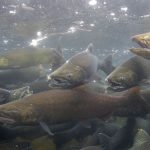The Lake Ontario Committee (LOC) recently announced trout and salmon stocking reductions in response to conclusive evidence of two successive years of poor alewife reproduction.
The stocking reductions, which are moderate in size, are intended to help reduce predatory demand on alewife, with the objective of fostering a robust forage base for the future.
The actions represent a consensus decision by the two-member LOC, composed of the New York State Department of Environmental Conservation (DEC) and the Ontario Ministry of Natural Resources and Forestry (OMNRF).
The stocking adjustments, which will commence in spring 2017, emphasize the LOCs shared commitment to the Lake Ontario Fish Community Objectives including restoring lake trout and sustaining Lake Ontario’s world-class salmon and trout fishery, with Chinook salmon as the top predator in the lake.
New York State and the Province of Ontario currently stock a combined 2.36 million Chinook salmon and more than one million lake trout each year into Lake Ontario.
In addition, approximately 50% of the Chinook salmon in Lake Ontario are naturally reproduced or “wild” fish. Stocked and wild salmon are supporting a world class fishery which produces the largest trophy Chinook salmon in the Great Lakes. Maintaining sufficient alewife abundance to support the sport fishery is key to long term success, and these stocking reductions will help achieve that goal.
Alewife are not native to the Great Lakes, and juvenile alewife cannot tolerate very cold water for long periods of time. The extremely long, cold winters of 2013/2014 and 2014/2015 resulted in poor survival of young alewife produced in those years.
The LOC is concerned that the two years of poor alewife survival will result in too few adult alewife, starting in 2017, to sustain the large numbers of trout and salmon in the lake.
To help reduce predator demand on alewife in 2018 and 2019, the LOC has agreed to reduce Chinook salmon stocking in 2017 by 20%. Given that, on average, 50% of Lake Ontario’s Chinook salmon are wild, this reduction effectively reduces Chinook salmon numbers added to the lake by only 10% in 2017.
In addition, lake trout stocking will also be reduced by 20% in 2017, which will reduce predator demand on alewife in 2020 and beyond.
Adult lake trout abundance is currently above restoration targets, and a reduction in stocking should not compromise restoration efforts. Under this action, DEC and OMNRF will still stock 1.88 million Chinook Salmon, 750,000 lake trout, and more than 2.45 million other trout and salmon into Lake Ontario in 2017.
DEC and OMNRF held numerous meetings with organized angler groups and the public to explain their concerns with Lake Ontario’s alewife population and discussed proposed management actions to address this issue. Stakeholders offered a wide variety of opinions and advice, ranging from more dramatic stocking reductions than those proposed to increasing stocking above bi-nationally approved limits.
For more information, visit the Lake Ontario Committee online at www.glfc.org/lakecom/loc/lochome.php.
source: Great Lakes Fishery Commission
